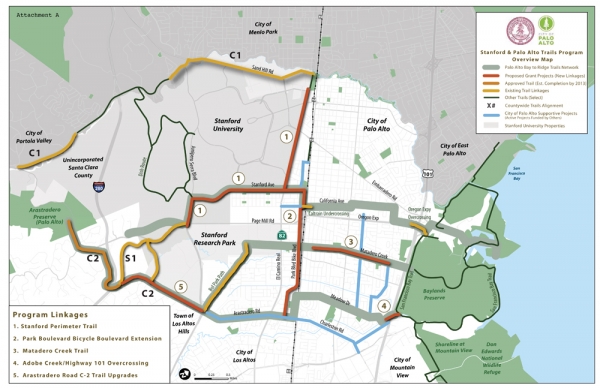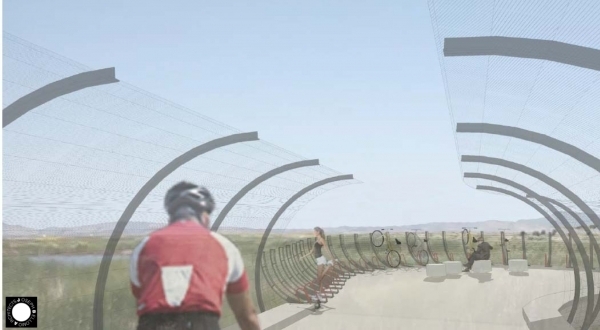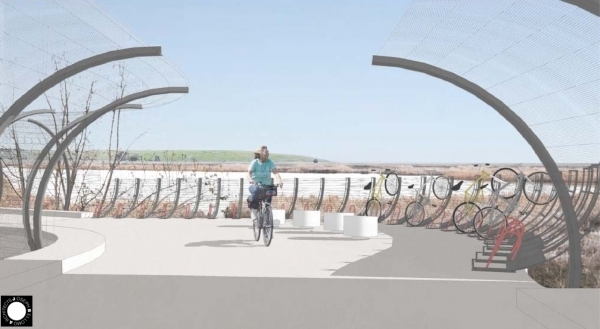After initial disagreements, Palo Alto and Stanford University have joined forces for a grant application that would fund a new bike bridge over U.S. Highway 101, extend a trail near the Stanford Dish and create a host of other trail improvements geared toward bicyclists and pedestrians.
The joint application, which the Palo Alto City Council is scheduled to discuss Tuesday night, Sept. 4, aims to tap into a $10.4 million fund that was created by Stanford University and handed over to Santa Clara County earlier this year as a "mitigation" for a General Use Permit (GUP) that the university had applied for 11 years ago. The permit allowed Stanford to construct up to 5 million square feet of new development on its campus.
The permit conditions had also committed Stanford to building trails to compensate campus users for the loss of recreational opportunities stemming from future campus development. One of these projects was scrapped last year after the San Mateo County Board of Supervisors voted not to accept the Stanford funds for a new trail on Alpine Road. This decision by San Mateo County prompted the Stanford to redirect the funds that would have been used for the trail to Santa Clara County.
Though the funds are no longer earmarked for any particular project, Stanford's agreement with the county specifies that they must be used for recreational opportunities benefiting campus users. In May, Santa Clara County Supervisor Liz Kniss proposed that $5 million of these funds be used to help construct a new bike bridge over U.S. Highway 101 at Adobe Creek -- a project that Palo Alto officials see as a critical component of the city's ambitious plan to greatly expand its bicycle network. Kniss' proposal also allocated $4 million to complete the Dumbarton Link in the Bay Trail between Redwood City and Alviso.
While Kniss' proposal was hailed by Palo Alto officials, it met resistance from Stanford residents, who consistently maintained that the funds should be used on projects that more directly benefit the campus community. The Stanford Campus Residential Leaseholders, an elected board that represents the residential community, had advocated that the funds be used to extend a path running along Stanford Avenue toward the Stanford Dish. Currently, the path stops short of the Dish.
Meanwhile, Stanford University officials said that while they don't oppose Palo Alto's bridge project, they would like to see the county consider a variety of different projects through a more thorough vetting process. That's the path the Board of Supervisors ultimately chose in May, when they delayed a decision on how the funds are to be used until October.
Since then, Palo Alto and Stanford University have come together to submit a joint proposal that would include both the bridge that the city wants and the expanded trail network that Stanford residents have long called for. The application calls for $4 million to be allocated to the bridge project; $4.5 million for new trails near the Dish (including a new trail on Juniperra Serra, between Old Page Mill Road and Stanford Avenue, an extension of one on Stanford Avenue between the Dish and El Camino Real; and another one on El Camino, between Stanford Avenue and Quarry Road); $200,000 for various traffic-calming measures on Park Boulevard (which the city plans to convert to its next "bicycle boulevard"); $1.5 million for a new trail along Matadero Creek; and $200,000 to replace and widen an existing trail along Arastradero Road, between Foothill Expressway and Purissima Road in Los Altos Hills.
View trail map (PDF)
The joint nature of the new proposal is underscored by its title -- "The Stanford and Palo Alto Trail Program: Connecting the Bay to Ridge." In a report to the council, Palo Alto's Chief Transportation Official Jaime Rodriguez wrote that the proposal's five linkages "together respond to the County's primary criteria and help to create a strong link between Stanford University and both the Baylands and the Arastradero Preserve."
Rodriguez also notes that the new proposal was designed to directly serve the campus residents and other community members who use Stanford's recreational facilities. It also "directly addresses the impact to Palo Alto and other local recreational facilities that will be impacted by the GUP build out."
"Staff believes that each linkage on its own meets the spirit of the requirement of the County program but when combined together represent an extraordinary opportunity to implement a series of new on-street and off-street trail elements that link together the Stanford Campus, Palo Alto park facilities and local amenities, and regional recreational facilities such as the Baylands and Arastradero Preserve," Rodriguez wrote.
The joint grant application, which is due to be submitted to the county by Sept. 6, was greeted with enthusiasm by the university officials and Stanford campus residents. Larry Horton, director of government and community relations at Stanford, called it a "terrific agreement" and a "historic collaboration" between the city and the university.
"I think it's very positive and I think it's an enormous benefit to both Stanford and Palo Alto," Horton said.
James Sweeney, president of the Stanford Campus Residential Leaseholders, also praised the agreement, which he said addresses the concerns of both the city and the campus residents. He noted that the proposal not only includes the projects that each side wants, but it also combines these projects into one integrated network of trails.
"The whole is actually better than the sum of its parts because it all fits together," Sweeney said. "The part that Palo Alto was putting in actually enhances the part we were proposing."
Sweeney said his group plans to submit a letter to the Santa Clara County Board of Supervisors supporting the joint application from the city and the Stanford.
The county is scheduled to hold a public hearing on proposals for the grant funding on Oct. 9.
Related stories:





Comments
Stanford
on Aug 31, 2012 at 10:29 am
on Aug 31, 2012 at 10:29 am
I'm all for the new pedestrian bridge over Hwy 101. That is certainly the most important project listed in this article.
But why is there no mention of a new pedestrian route from Stanford across I-280? The article does mention the "Bay To Ridge" project, but the main gap in this project is the lack of a safe pedestrian route along the Page Mill Road corridor between the Stanford campus and the Arastradero Preserve on the west side of I-280. Most of the rest of the trail projects listed in this article are trivial compared to closing the I-280 gap.
Palo Verde
on Aug 31, 2012 at 10:36 am
on Aug 31, 2012 at 10:36 am
In case anyone missed it, there's an embedded link to a 4.4 MB pdf file with a full resolution version of the thumbnail map pictured in this story photo. Web Link
another community
on Aug 31, 2012 at 10:55 am
on Aug 31, 2012 at 10:55 am
It took more than a decade and a myriad underhanded shenanigans for SU to finally get near to fulfilling its promises. Meanwhile it reaped all the benefits of constant construction. The bridge is the best part.
Registered user
Atherton
on Aug 31, 2012 at 11:10 am
Registered user
on Aug 31, 2012 at 11:10 am
Well done Stanford - you have managed to overcome the obfuscation and diversions and foot dragging by the local political entities and the disgruntled citizens who simply want to kill the goose that continues to lay golden eggs.
There is nothing in this deal that they could not have easily accepted 10 years ago.
It is a shame that it is so hard to get your partners to do the right thing, particularly when they point to you as the problem instead of looking at them selves in the mirror.
University South
on Aug 31, 2012 at 11:20 am
on Aug 31, 2012 at 11:20 am
Palo Alto created its first bicycle trails in 1972 - 42 miles. Originally the Council wanted about 65 miles, but citizens objected.
These proposed new trails should be reviewed by the Parks and Recreation
Committee and the Planning/Trans. Committee so the public can really understand what is being proposed. Some of these trails are almost impossible to get to and there is no parking if one wanted to start at a midpoint. Also, Palo Alto staff ought to know enough to refer to the Preserve as the Pearson-Arastradero Preserve.
One other idea might be to urge the City to install MORE benches throughout the City. This would clearly encourage more walking. The
goal of making Palo Alto a walkable city might be easier to attain.
People of all ages walk, but not everyone can bike.
This is a positive step for Palo Alto.
Another Palo Alto neighborhood
on Aug 31, 2012 at 11:45 am
on Aug 31, 2012 at 11:45 am
"The goal of making Palo Alto a walkable city might be easier to attain."
Here we go again, another perpetuation of the myth that Palo Alto is a walkable city. Maybe if you live in Midtown it is walkable as far as shopping and services go, though the Safeway is pathetically small. Otherwise, we lost two shopping centers that could have made their nearby areas walkable (Alma Plaza and Edgewood)--makes you wonder how serious our leaders are about what they claim to want.
Besides that most areas are not walkable--for various reasons. Let's get past this myth and try to make it easier for all forms of transportation to work in Palo Alto.
Stanford
on Aug 31, 2012 at 12:39 pm
on Aug 31, 2012 at 12:39 pm
I am delighted that Palo Alto and Stanford have finally gotten together on this project, which should be of benefit to many people in the area. While they are at it, maybe they could do one more thing, which is to alleviate the parking mess on Stanford Avenue. The present arrangement is not just inconvenient, it is dangerous, with cars double-parked waiting for a space to open, sudden U-turns, pedestrians walking in the roadway and the like. There was even a death several there several years ago. If Palo Alto, Stanford and the County of Santa Clara (if necessary) could agree to put a new parking area somewhere near the corner of Junipero Serra Blvd. and Page Mill Road (or Old Page Mill Road), that would be a great leap forward. Since the present proposal calls for a walking path in that area, the add-on should amount to very little.
Stanford
on Aug 31, 2012 at 12:53 pm
on Aug 31, 2012 at 12:53 pm
Are there bike racks at the Stanford Dish trail? I usually jog there, so don't look for them. If there are not bike racks, adding them would give people another option for getting there without driving, thus reducing congestion and danger on the roads. Put the bike racks near the guard station to deter bike theft.
Crescent Park
on Aug 31, 2012 at 1:16 pm
on Aug 31, 2012 at 1:16 pm
"Some of these trails are almost impossible to get to ..."
Interesting; which trails?
"... and there is no parking if one wanted to start at a midpoint."
I'm not sure I follow the logic here; where is mid-trail parking wise?
Fairmeadow
on Aug 31, 2012 at 1:21 pm
on Aug 31, 2012 at 1:21 pm
Good work, both Stanford and Palo Alto! You're setting an example of collaborative effort—hope those folks in Washington notice that it can be done.
I'm particularly looking forward to that bridge over 101.
Midtown
on Aug 31, 2012 at 8:22 pm
on Aug 31, 2012 at 8:22 pm
1. The proposed bicycle/pedestrian overpass at Adobe Creek/Hwy 101, as currently designed, is an extravaganza totally out of step with today's economic realities. What a waste of scarce resources!
d
2. The incomprehensibly ill-conceivetrail just south/west of Page Mill Road (the trail from nowhere to nowhere and designed for nobody) should be mothballed. Stanford might consider issuing an apology for that affront to potential users.
3. A new trail should be opened/built from the Stanford Dish, proceeding under I-280, via the existing cow crossing bridge, and continuing to the Pearson-Arastradero Park. Thus, a viable connection would be established with the Bay Area Trail, leading through the Arastradero, the P.A. Foothills Park, Los Trancos, Montebello and so on.
4. The suggestion of a major, secure bicycle parking facility close to Stanford Ave & Junipero Serra should be implemented and a similar facility should be established at the north/east entrance to the Dish
(close to the intersection of Junipero Serra and Campus Drive East).
So be it!
Registered user
Atherton
on Sep 1, 2012 at 7:37 am
Registered user
on Sep 1, 2012 at 7:37 am
"4. The suggestion of a major, secure bicycle parking facility close to Stanford Ave & Junipero Serra should be implemented and a similar facility should be established at the north/east entrance to the Dish"
On whose land should these be built?
Who will pay for the land?
Who will pay for the security?
Barron Park
on Sep 2, 2012 at 6:52 am
on Sep 2, 2012 at 6:52 am
TRAILS!
YAH TRAILS!
YAILS!!
Registered user
Barron Park
on Sep 3, 2012 at 3:32 am
Registered user
on Sep 3, 2012 at 3:32 am
It is great to see a collaborative effort by the city and Stanford, and the cohesive integration of several trail segments to build out timely portions of Palo Alto's long-planned Bay to Ridge Trails. Thank you to those who developed this win-win proposal.
I'm especially excited for the Matadero Creek trail segment. I used to volunteer as a creek monitor on Matadero from Louis to the Baylands, and so I had permission to walk along the existing maintenance path. I have long thought that this could fairly easily be made into a public trail. Increased public interaction with and enjoyment of our creeks and waterways has tremendous individual and collective benefit. We will need to make sure the street crossings are made clear for trail users and drivers.
______________
The first poster, "Pedestrian" asked why no mention about getting across 280 along Page Mill. I believe likely the reason is that there is movement to improve and increase the safety of the 280/Page Mill interchange, with opportunities for public input forthcoming. This Tuesday 9/4, the Palo Alto Bicycle Advisory Committee (PABAC) will be presented with interchange concepts and give feedback regarding the bicyclist perspective. PABAC meetings are open to the public, they are at 7:30 pm the first Tuesday of each month, and will be meeting at Cubberly Community Center, Room H5. This item is scheduled for 7:50 on the agenda, but it could be earlier or later than that, best to just come at 7:30 to minimize disruption.
______________
Regarding bike parking at the dish, there are racks at the north east corner of Stanford/Junipero Serra, though I agree it would be nice to have bike parking on the park side of Junipero, and in site of the existing guard stand.
______________
To 'Palo Alto is not walkable', it would be more helpful to clarify what you think is not walkable and what might improve the problems your perceive. I've lived here almost all my life and have experienced this city as a wonderful place to walk, generally safe with many beautiful trees, interesting yards, and friendly people. Sure there are areas where improvements could improve safety and convenience, and practices of (sub)urban development which can improve walkability. While I do not agree with your blanket conclusion that this city is not walkable, I do agree with pursuing a policy of complete streets, to accomodate all users of the streets regardless of their mode of locomotion.
Registered user
Barron Park
on Sep 3, 2012 at 3:36 am
Registered user
on Sep 3, 2012 at 3:36 am
Oops, typo: the bike parking should be "in sight" not "in site" of the existing guard stand.